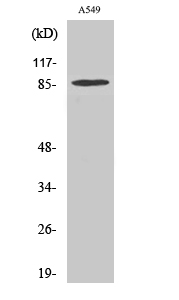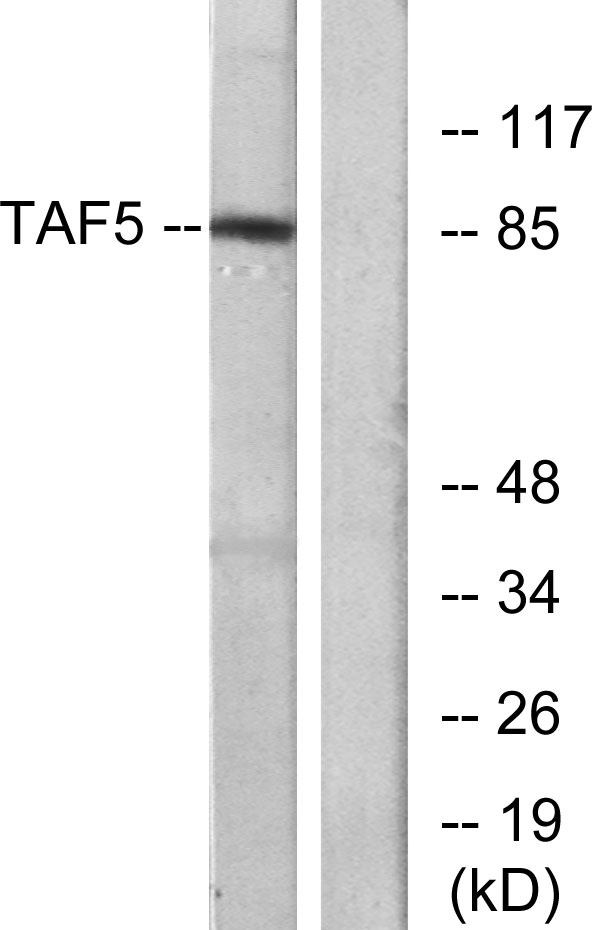TAF II p100 Polyclonal Antibody
- Catalog No.:YT4526
- Applications:WB;IHC;IF;ELISA
- Reactivity:Human;Mouse
- Target:
- TAF II p100
- Fields:
- >>Basal transcription factors
- Gene Name:
- TAF5
- Protein Name:
- Transcription initiation factor TFIID subunit 5
- Human Gene Id:
- 6877
- Human Swiss Prot No:
- Q15542
- Mouse Gene Id:
- 226182
- Mouse Swiss Prot No:
- Q8C092
- Immunogen:
- The antiserum was produced against synthesized peptide derived from human TAF5. AA range:381-430
- Specificity:
- TAF II p100 Polyclonal Antibody detects endogenous levels of TAF II p100 protein.
- Formulation:
- Liquid in PBS containing 50% glycerol, 0.5% BSA and 0.02% sodium azide.
- Source:
- Polyclonal, Rabbit,IgG
- Dilution:
- WB 1:500 - 1:2000. IHC 1:100 - 1:300. ELISA: 1:5000.. IF 1:50-200
- Purification:
- The antibody was affinity-purified from rabbit antiserum by affinity-chromatography using epitope-specific immunogen.
- Concentration:
- 1 mg/ml
- Storage Stability:
- -15°C to -25°C/1 year(Do not lower than -25°C)
- Other Name:
- TAF5;TAF2D;Transcription initiation factor TFIID subunit 5;Transcription initiation factor TFIID 100 kDa subunit;TAF(II)100;TAFII-100;TAFII100
- Observed Band(KD):
- 87kD
- Background:
- Initiation of transcription by RNA polymerase II requires the activities of more than 70 polypeptides. The protein that coordinates these activities is transcription factor IID (TFIID), which binds to the core promoter to position the polymerase properly, serves as the scaffold for assembly of the remainder of the transcription complex, and acts as a channel for regulatory signals. TFIID is composed of the TATA-binding protein (TBP) and a group of evolutionarily conserved proteins known as TBP-associated factors or TAFs. TAFs may participate in basal transcription, serve as coactivators, function in promoter recognition or modify general transcription factors (GTFs) to facilitate complex assembly and transcription initiation. This gene encodes an integral subunit of TFIID associated with all transcriptionally competent forms of that complex. This subunit interacts strongly wi
- Function:
- domain:Distinct domains of TAF5/TAFII100 are required for functional interaction with transcription factor TFIIFB (RAP30) and incorporation into the TFIID complex.,function:TAFs are components of the transcription factor IID (TFIID) complex, PCAF histone acetylase complex and TBP-free TAFII complex (TFTC). TAFs components-TIIFD are essential for mediating regulation of RNA polymerase transcription. TAF5/TAFII100 interacts strongly with the histone H4-related TAF6/TAFII80 and the histone H3-related TAF9/TAFII31, as well as a stable complex comprised of both TAF5/TAFII80 and TAF6/TAFII31. Apparently weaker interactions of TAF5/TAFII100 with TBP, TAF1/TAFII250, TAF11/TAFII28, and TAF12/TAFII20, but not TAF7/TAFII55, also have been observed.,similarity:Belongs to the WD repeat TAF5 family.,similarity:Contains 1 LisH domain.,similarity:Contains 6 WD repeats.,subunit:TFIID and PCAF are compose
- Subcellular Location:
- Nucleus.
- Expression:
- Brain,Cervix carcinoma,Prostate,Testis,
- June 19-2018
- WESTERN IMMUNOBLOTTING PROTOCOL
- June 19-2018
- IMMUNOHISTOCHEMISTRY-PARAFFIN PROTOCOL
- June 19-2018
- IMMUNOFLUORESCENCE PROTOCOL
- September 08-2020
- FLOW-CYTOMEYRT-PROTOCOL
- May 20-2022
- Cell-Based ELISA│解您多样本WB检测之困扰
- July 13-2018
- CELL-BASED-ELISA-PROTOCOL-FOR-ACETYL-PROTEIN
- July 13-2018
- CELL-BASED-ELISA-PROTOCOL-FOR-PHOSPHO-PROTEIN
- July 13-2018
- Antibody-FAQs
- Products Images

- Western Blot analysis of various cells using TAF II p100 Polyclonal Antibody

- Immunohistochemistry analysis of paraffin-embedded human liver carcinoma tissue, using TAF5 Antibody. The picture on the right is blocked with the synthesized peptide.

- Western blot analysis of lysates from A549 cells, using TAF5 Antibody. The lane on the right is blocked with the synthesized peptide.


